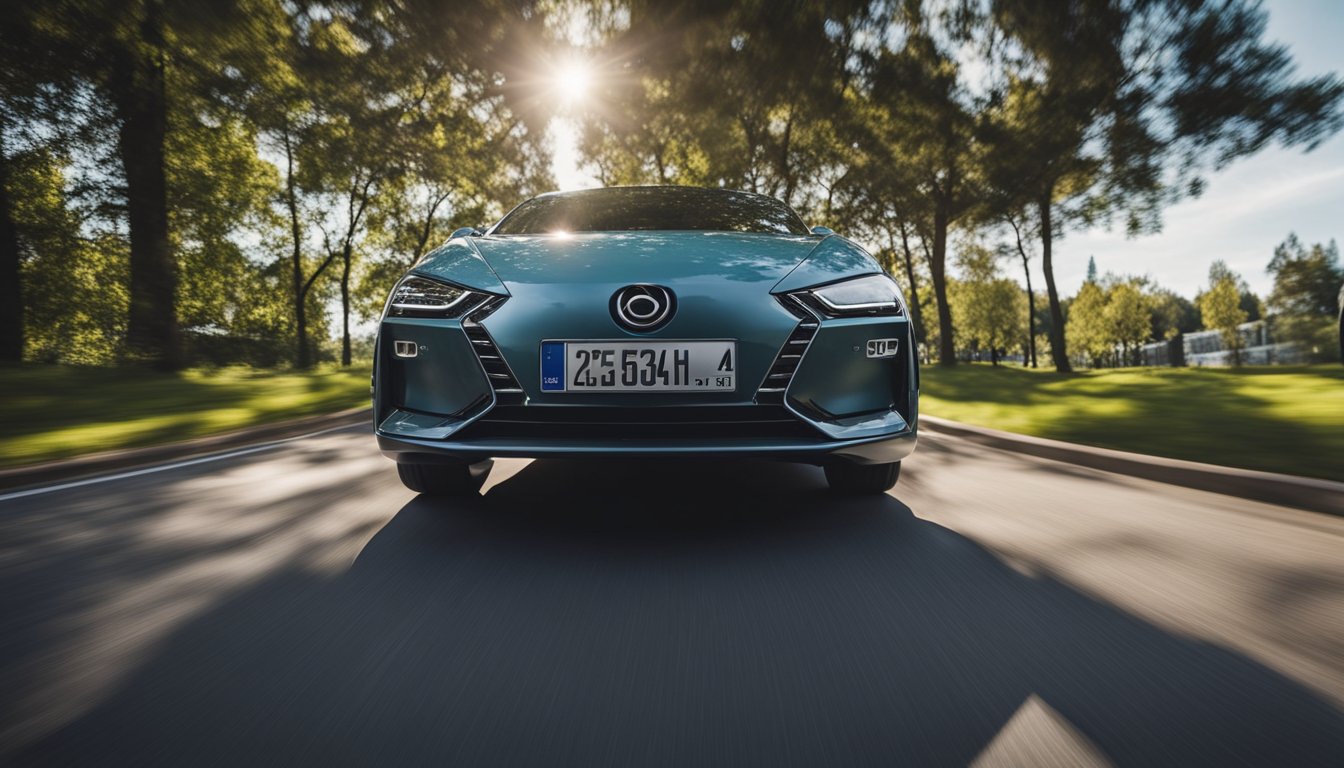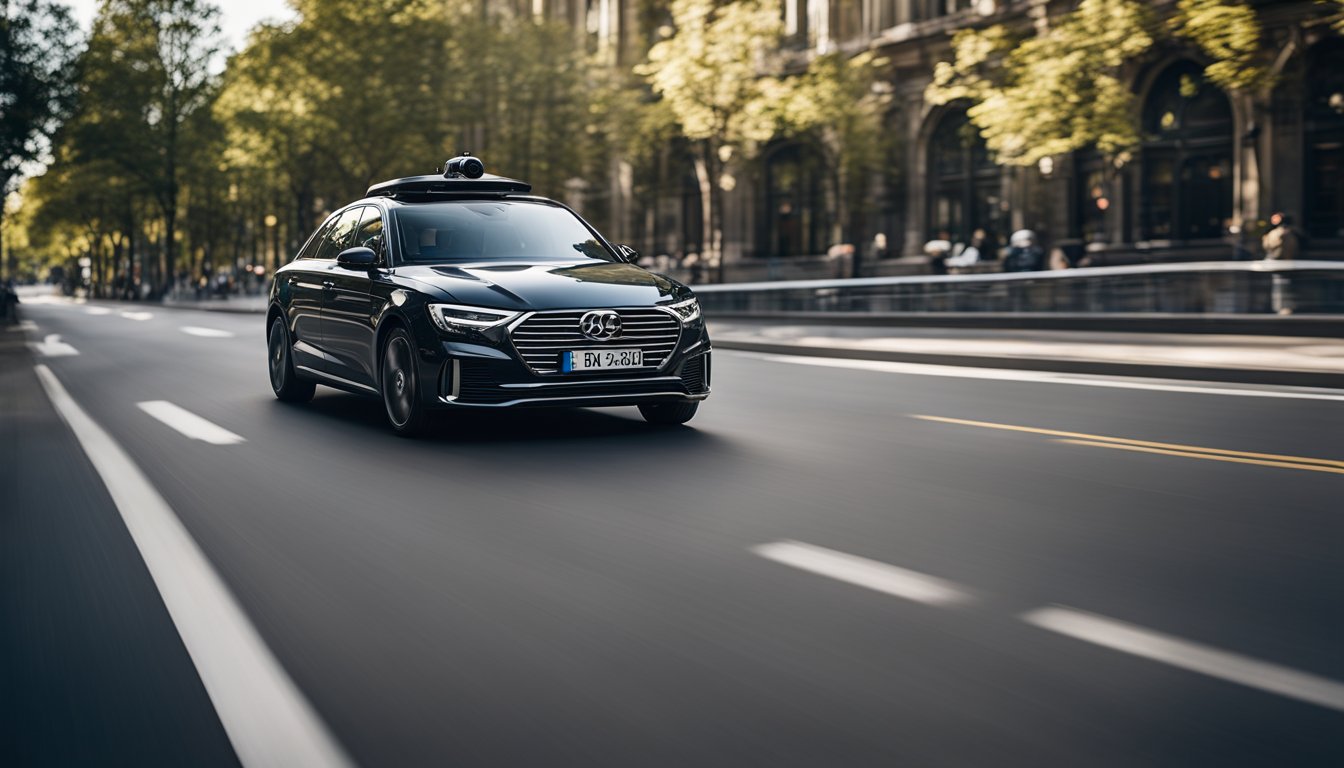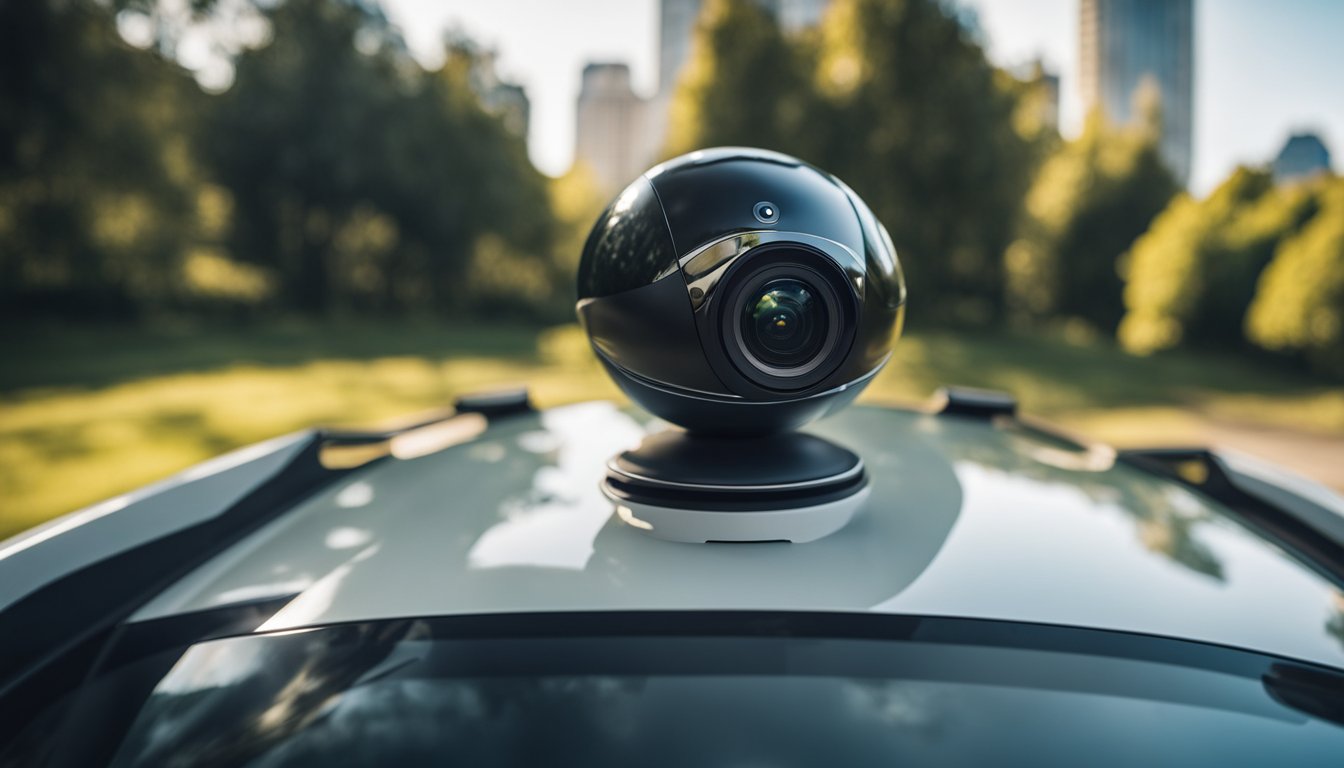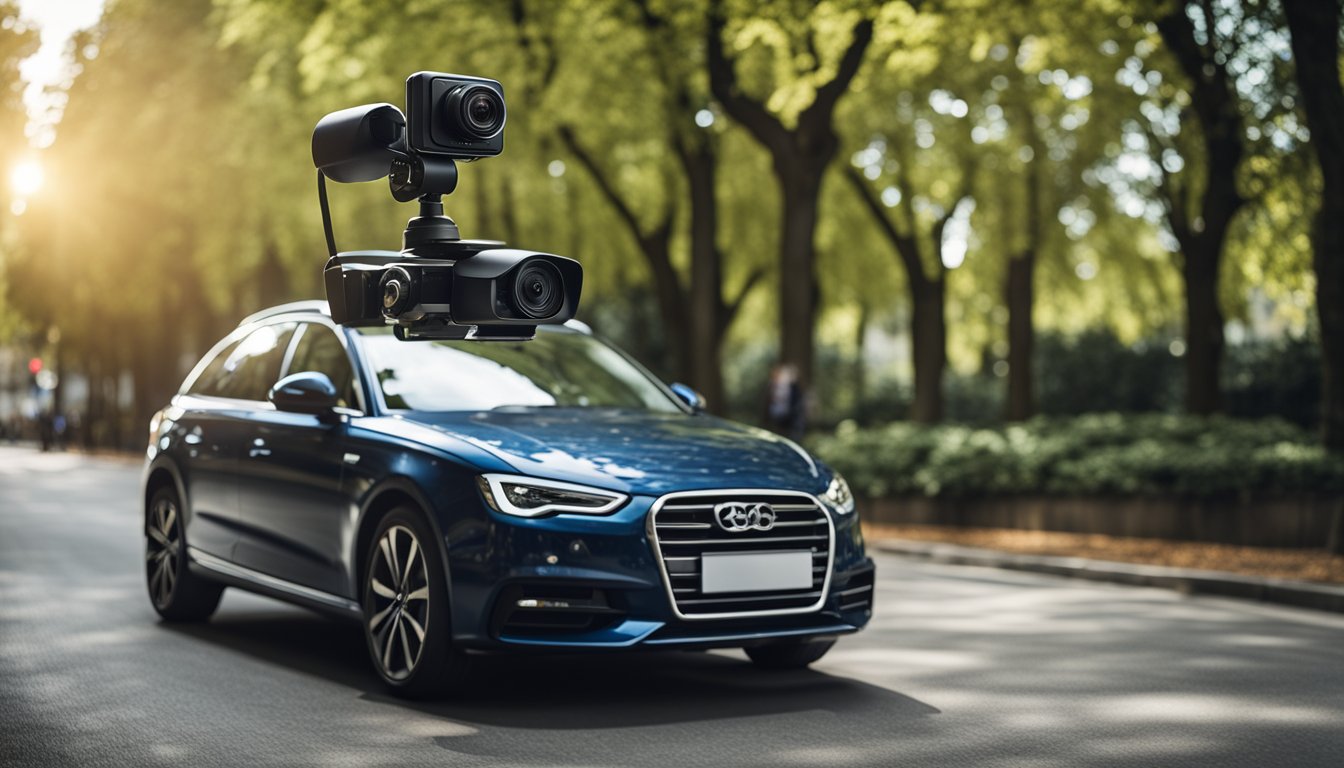360-degree cameras have become increasingly popular in cars in recent years, providing drivers with a comprehensive view of their surroundings. These cameras use multiple lenses to capture a 360-degree view of the car’s environment, which is then stitched together to create an image that can be displayed on the car’s screen. This technology has revolutionized the driving experience, making it easier and safer to park, maneuver, and navigate through tight spaces.
Understanding the basics of how 360-degree cameras work on cars is essential to appreciate the benefits of this technology. The cameras are integrated with the vehicle’s systems, allowing drivers to see a bird’s eye view of their car and its surroundings. Parking assistance features are also commonly included, which can help drivers park in tight spaces and avoid obstacles. The design and placement of the cameras, as well as the technology used, can vary depending on the car manufacturer and the specific system used.
Key Takeaways
- 360-degree cameras use multiple lenses to create a comprehensive view of the car’s environment.
- These cameras are integrated with the vehicle’s systems, providing drivers with parking assistance features and a bird’s eye view of their car and its surroundings.
- The design, placement, and technology of 360-degree cameras can vary depending on the car manufacturer and the specific system used.
Understanding the Basics of 360 Cameras on Cars
https://www.youtube.com/watch?v=fdDZaH8hg1A&embed=true
If you’re looking for a safer and more convenient way to park your vehicle, a 360-degree camera is a must-have feature. This advanced camera system provides drivers with a bird’s-eye view of their surroundings, making it easier to avoid obstacles and park in tight spots. In this section, we’ll take a closer look at the basics of 360 cameras on cars.
What Is a 360-Degree Camera?
A 360-degree camera, also known as a surround view camera, is a type of camera system that provides a complete view of the area around a vehicle. This camera system uses multiple cameras mounted on different parts of the vehicle to capture a full 360-degree view. The images from these cameras are then stitched together to create a seamless, panoramic view of the vehicle’s surroundings.
Key Components of a Surround View System
A surround view system is made up of several key components, including cameras, sensors, and processing software. Here’s a closer look at each of these components:

-
Cameras: A surround view system typically uses four cameras, one on each side of the vehicle. These cameras capture images of the vehicle’s surroundings, which are then processed by the system’s software to create a 360-degree view.
-
Sensors: In addition to cameras, a surround view system also uses sensors to detect obstacles and provide additional information to the driver. These sensors can include ultrasonic sensors, radar sensors, and LiDAR sensors.
-
Processing Software: The images and data captured by the cameras and sensors are processed by specialized software, which creates a seamless, panoramic view of the vehicle’s surroundings. This software can also provide additional features, such as parking guidance and object detection.
With a 360-degree camera system, you’ll have a complete view of your vehicle’s surroundings, making it easier to park and avoid obstacles. Whether you’re navigating a crowded parking lot or backing into a tight space, a surround view system can provide the peace of mind you need to drive with confidence.
Integration with Vehicle Systems
A 360-degree camera system is a sophisticated technology that requires integration with various vehicle systems to function correctly. In this section, we will discuss the two primary aspects of integration: connection to the infotainment system and software and image processing.
Connection to Infotainment System
The 360-degree camera system is connected to the infotainment system of the car, which displays the camera’s output on the car’s screen. The camera system is integrated with the infotainment system through a High-Definition Multimedia Interface (HDMI) or a dedicated camera input.
The camera’s output is displayed on the infotainment screen, and you can switch between different camera views using the infotainment system’s controls. For instance, you can view a bird’s eye view of the car, a rearview, or a front view.
Software and Image Processing
« Can You Add a 360 Camera to Your Mercedes?
SUVs with 360 Cameras: Top Models for Ultimate Visibility »
The 360-degree camera system comprises several cameras that capture images of the car’s surroundings. The images are then processed by specialized image processing software that stitches them together to create a seamless 360-degree view.
The software also removes any distortion caused by the wide-angle lens and eliminates any overlapping bits of the images. Additionally, the software creates a graphic of the car and overlays it onto the 360-degree view to give you a better perspective of the car’s position.
The image processing software is also responsible for displaying gridlines on the infotainment screen, which helps you park the car accurately. The gridlines change color to indicate the distance between the car and any obstacles in its path.
In conclusion, the 360-degree camera system is a sophisticated technology that requires integration with various vehicle systems to function correctly. The system is connected to the infotainment system, which displays the camera’s output on the car’s screen, and it uses specialized image processing software to create a seamless 360-degree view of the car’s surroundings.
Parking Assistance Features
https://www.youtube.com/watch?v=ByX6R1DTfJs&embed=true
If you struggle with parking or have difficulty maneuvering in tight spots, a 360-degree camera parking system can be a lifesaver. These systems come with a range of features to make parking easier and less stressful.
Automated Parking Sensors
One of the key features of a 360-degree camera parking system is the automated parking sensors. These sensors use ultrasonic waves to detect obstacles around the car, allowing you to park with greater accuracy and safety. The sensors can detect objects that are invisible to the naked eye, such as low curbs or bollards, and alert you with a beeping sound or visual warning on the display.
Real-Time View and Guidelines
Another important feature of a 360-degree camera parking system is the real-time view and guidelines. The system uses multiple cameras positioned around the car to provide a bird’s-eye view of your surroundings. You can see everything around you in real-time, including obstacles, pedestrians, and other vehicles. The display also includes guidelines to help you park with greater accuracy. These guidelines show you the trajectory of your car and where it will end up, so you can adjust your steering and speed accordingly.
The real-time view and guidelines are especially helpful when parking in tight spots or parallel parking. With a 360-degree camera parking system, you can park with greater precision and confidence, even in the most challenging situations.
Overall, a 360-degree camera parking system is a valuable parking aid that can make your life easier and safer. With automated parking sensors and a real-time view with guidelines, you can park with greater accuracy and confidence, even in the tightest of spots.
Camera Technology and Vehicle Safety
https://www.youtube.com/watch?v=xqWkJJOcU4g&embed=true
When it comes to driving, safety is a top priority. One of the most significant advancements in vehicle safety technology is the 360-degree camera system. This system provides drivers with a bird’s-eye view of their surroundings, allowing them to navigate tight spaces and avoid collisions. In this section, we’ll explore how this technology works and how it enhances vehicle safety.
Proximity Sensors and Blind Spot Reduction
One of the key features of the 360-degree camera system is its integration with proximity sensors and blind spot reduction technology. Proximity sensors use ultrasonic waves to detect objects in close proximity to the vehicle. When an object is detected, the system alerts the driver with an audible warning or visual indicator. This technology is particularly useful when parking or maneuvering in tight spaces.
Blind spot reduction technology uses cameras and sensors to monitor the vehicle’s blind spots. When an object is detected in the blind spot, the system alerts the driver with a warning light or audible alert. When combined with the 360-degree camera system, drivers have a complete view of their surroundings, reducing the risk of collisions.
High-Resolution Cameras and Distortion Correction
The 360-degree camera system uses multiple high-resolution cameras to capture a complete view of the vehicle’s surroundings. These cameras are strategically placed around the vehicle to provide a seamless view from all angles. The cameras are equipped with distortion correction technology, which removes the fish-eye effect caused by wide-angle lenses. This technology ensures that the images captured by the cameras are accurate and distortion-free.
The images captured by the cameras are processed by software that stitches them together to create a seamless 360-degree view. The resulting image is displayed on the vehicle’s screen, giving drivers a complete view of their surroundings. This technology is particularly useful when parking or navigating tight spaces, as it provides drivers with a clear view of their surroundings.
In conclusion, the 360-degree camera system is a significant advancement in vehicle safety technology. Its integration with proximity sensors and blind spot reduction technology, along with its use of high-resolution cameras and distortion correction, makes it an essential feature for any vehicle. With this technology, drivers can navigate tight spaces and avoid collisions with ease, making the roads safer for everyone.
Design and Placement of Cameras
When it comes to designing and placing 360 cameras in cars, there are a few things to consider. In this section, we’ll take a look at the strategic camera locations and the wide-angle lenses used to capture the field of view.
Strategic Camera Locations
360 cameras in cars are usually placed in strategic locations to capture a complete view of the car’s surroundings. These cameras are typically placed on the front, rear, and sides of the car. Some cars also have cameras mounted on the side mirrors to capture blind spots.
The top view camera is mounted on the roof of the car and captures a bird’s eye view of the car and its surroundings. This camera is particularly useful for parking in tight spaces or navigating through congested areas.
Wide-Angle Lenses and Field of View
360 cameras use wide-angle lenses to capture a wider field of view. These lenses are designed to capture as much of the surroundings as possible, which is essential for providing drivers with a complete view of their surroundings.
The field of view of a 360 camera depends on the type of lens used and its placement. Typically, the wider the lens, the larger the field of view. This is why cameras with fisheye lenses are popular for 360 cameras.
To ensure that the cameras capture the entire field of view, they are typically mounted at an angle. This allows the camera to capture more of the surroundings and reduces the risk of blind spots.
In summary, the design and placement of 360 cameras in cars is critical to providing drivers with a complete view of their surroundings. By strategically placing cameras and using wide-angle lenses, car manufacturers can provide drivers with a safer driving experience.
The User Experience
https://www.youtube.com/watch?v=X38sjawXo0I&embed=true
When it comes to using a 360-degree camera in your car, the user experience is designed to be as easy and intuitive as possible. Here are a few factors that contribute to the user experience of a 360-degree camera system in a car:
Ease of Use
360-degree camera systems are designed to make parking and maneuvering your car easier and safer. Once you engage the camera system, you’ll see a bird’s-eye view of your car on the infotainment screen, with a live feed from each of the cameras. This gives you a complete view of your surroundings, including any obstacles or blind spots that might be difficult to see otherwise.
To switch between camera views, simply select the camera you want to view from the infotainment screen. Some systems may also allow you to zoom in on specific areas or adjust the brightness and contrast of the camera feed to suit your preferences.
Infotainment Screen Interaction
The infotainment screen is the primary way that you’ll interact with your car’s 360-degree camera system. Most systems will allow you to adjust settings and view camera feeds directly from the screen, using either touch controls or physical buttons on the dashboard.
In addition to the camera system itself, many infotainment screens also offer other features that can enhance your driving experience, such as GPS navigation, music playback, and climate control. By integrating all of these features into a single interface, car manufacturers aim to make it easier and more convenient for you to control all aspects of your car from one central location.
Car Manufacturer Specific Systems
https://www.youtube.com/watch?v=EXcdhJunrzk&embed=true
If you’re in the market for a new car, you may have noticed that many newer models come with a 360-degree camera system. These systems use multiple cameras to provide a bird’s-eye view of your car, making it easier to park and maneuver in tight spaces. In this section, we’ll take a closer look at some of the car manufacturer-specific systems available.
Ford’s Surround View System
Ford’s Surround View System uses four cameras to provide a 360-degree view of your car. The system is available on select Ford models, including the F-150, Explorer, and Mustang. The cameras are placed on the front, rear, and sides of the car, and the images are stitched together to create a seamless view. The system also includes a split-view display that shows a front view and a rear view at the same time.
Audi’s Top View Camera
Audi’s Top View Camera is available on select models, including the A4, A5, and Q5. The system uses four cameras to provide a 360-degree view of your car, which is displayed on the infotainment screen. The cameras are placed on the front, rear, and sides of the car, and the images are stitched together to create a seamless view. The system also includes a zoom function that allows you to get a closer look at specific areas around your car.
Hyundai and Kia’s Around View Monitor
Hyundai and Kia’s Around View Monitor is available on select models, including the Hyundai Santa Fe and the Kia Sorento. The system uses four cameras to provide a 360-degree view of your car, which is displayed on the infotainment screen. The cameras are placed on the front, rear, and sides of the car, and the images are stitched together to create a seamless view. The system also includes a parking guide that shows you where to park your car.
Overall, these car manufacturer-specific systems provide a convenient and safe way to park and maneuver your car. If you’re in the market for a new car, be sure to check if any of these systems are available on the models you’re interested in.
Aftermarket 360 Camera Kits
https://www.youtube.com/watch?v=p-6xglcAFZc&embed=true
If your car does not come with a 360-degree camera system, you can always install an aftermarket kit to add this feature to your vehicle. Here are some things to consider when choosing an aftermarket kit:
Choosing the Right Aftermarket Kit
When shopping for an aftermarket kit, make sure to choose a product that is compatible with your car’s make and model. You’ll also want to consider the quality of the cameras included in the kit. Look for cameras with high resolution and a wide field of view to ensure that you get a clear and comprehensive view of your surroundings.
Installation and Calibration
Installing an aftermarket 360 camera kit requires some technical know-how. If you’re not comfortable doing the installation yourself, you can always take your car to a service center to have the kit installed. Once the kit is installed, the cameras will need to be calibrated to ensure that they are all pointing in the right direction and providing accurate images.
Camera calibration is a crucial step in the installation process. If the cameras are not calibrated properly, the images they produce will be distorted or inaccurate. Calibration involves adjusting the cameras’ angles and positions to ensure that they are all aligned and providing a seamless 360-degree view.
In conclusion, adding a 360-degree camera system to your car is a great way to improve your driving experience and increase your safety on the road. With the right aftermarket kit and proper installation and calibration, you can enjoy all the benefits of this advanced technology.
Evolution of 360 Cameras in the Automotive Industry
https://www.youtube.com/watch?v=pL4FWP8LM1k&embed=true
With the advancement of technology, 360-degree cameras have become a mainstream feature in the automotive industry. These cameras provide drivers with a complete view of their surroundings, eliminating blind spots and making parking and reversing easier. In this section, we will discuss the evolution of 360 cameras in the automotive industry, from luxury to mainstream, and future trends and smart integration.
From Luxury to Mainstream
Initially, 360 cameras were only available in luxury cars. However, with the increasing demand for safety features and advancements in technology, 360 cameras have become more affordable and are now available in mainstream cars. According to MotorTrend, 360-degree camera systems are now available in most mid-range cars.
Future Trends and Smart Integration
As technology continues to evolve, we can expect to see more advanced features in 360 cameras. For example, some cars now have cameras that can detect pedestrians and other objects, which can help prevent accidents. In the future, we may also see 360 cameras integrated with smartphones, allowing drivers to view their surroundings from their phone.
Smart integration is another trend we can expect to see in the future. According to Embitel, smart integration will allow 360 cameras to communicate with other sensors in the car, such as radar and lidar, to provide a more comprehensive view of the surroundings. This will help improve safety and prevent accidents.
In conclusion, 360 cameras have come a long way since their introduction in luxury cars. They have become a mainstream feature in the automotive industry, and we can expect to see more advanced features and smart integration in the future.
Troubleshooting Common Issues
https://www.youtube.com/watch?v=ITNq3BilX8g&embed=true
If you are experiencing issues with your 360-degree camera, don’t worry, it is a common problem that many car owners face. Here are some of the most common issues and how to troubleshoot them.
Software Glitches and Updates
One of the most common issues with 360-degree cameras is software glitches. If you notice that your camera is not working properly, it is possible that you need to update the software. Check with your car manufacturer to see if there are any updates available for your camera.
Another solution is to reset the camera system. This can be done by disconnecting the car battery for a few minutes. Once you reconnect the battery, the camera system should reset itself and start working properly again.
Camera Maintenance and Service
Another common issue with 360-degree cameras is maintenance. Over time, the camera lenses can become dirty or scratched, which can affect the quality of the image. To avoid this, make sure to clean the camera lenses regularly. You can use a microfiber cloth or a lens cleaning solution to clean the lenses.
If you notice that your camera is still not working properly after cleaning the lenses, it may be time to take your car in for service. A professional technician can inspect the camera system and make any necessary repairs or replacements.
In conclusion, if you are experiencing issues with your 360-degree camera, don’t panic. Try troubleshooting the issue by updating the software or resetting the camera system. If the issue persists, consider taking your car in for service to ensure that your camera system is working properly.
Legal and Privacy Considerations
When it comes to using a 360 camera in your car, there are certain legal and privacy considerations that you should be aware of. In this section, we’ll discuss some of the key points to keep in mind.
Recording Laws and Regulations
Before installing a 360 camera in your car, it’s important to understand the laws and regulations in your area regarding recording. In some states or countries, it may be illegal to record video or audio without the consent of all parties involved. It’s important to do your research and ensure that you are complying with all relevant laws and regulations.
Data Protection and Privacy
Another important consideration is data protection and privacy. If you are using a 360 camera in your car, you are collecting footage of the public, which can include other drivers, pedestrians, and bystanders. It’s important to be aware of the privacy concerns that come with collecting this type of data.
One way to address these concerns is to clearly display a notice in your car that alerts passengers and others that they may be recorded. You should also be careful about how you store and share the footage from your 360 camera. Make sure that you are protecting the data and only sharing it with trusted parties.
Overall, it’s important to be aware of the legal and privacy considerations when using a 360 camera in your car. By taking the time to understand the laws and regulations in your area and being mindful of data protection and privacy concerns, you can ensure that you are using your 360 camera in a responsible and ethical manner.
Frequently Asked Questions
https://www.youtube.com/watch?v=OpPpbE_udss&embed=true
What is the purpose of a 360-degree camera in vehicles?
A 360-degree camera system in a car is designed to give drivers a bird’s eye view of the vehicle’s surroundings. This technology helps drivers avoid accidents by providing a comprehensive view of the car’s immediate environment.
Can you explain the technology behind a car’s bird’s eye view camera system?
A 360-degree camera system uses multiple cameras installed in strategic locations around the car to capture a panoramic view of the vehicle’s surroundings. These cameras are usually placed on the car’s front grille, under the side mirrors, and the rear end of the car. The images captured by these cameras are then processed by a computer and stitched together to create a seamless 360-degree view of the car’s surroundings.
What are the typical costs associated with installing a 360-degree camera on a car?
The cost of installing a 360-degree camera system on a car can vary depending on the make and model of the vehicle. However, the average cost of installing a 360-degree camera system on a car is between $500 to $2000.
What makes a 360 camera system a valuable addition to car safety features?
A 360-degree camera system is a valuable addition to car safety features because it provides drivers with a comprehensive view of their surroundings, reducing the risk of accidents. This camera system is especially helpful when parking in tight spaces or navigating through crowded areas.
How do 360-degree cameras on cars provide a view of the vehicle’s rooftop?
The 360-degree camera system in a car uses cameras installed on the car’s roof to provide a view of the vehicle’s rooftop. These cameras capture images of the car’s surroundings and are processed by a computer to create a seamless 360-degree view of the car’s environment.
What are some budget-friendly car models that come equipped with a 360-degree camera?
Some budget-friendly car models that come equipped with a 360-degree camera system include the 2023 Nissan Rogue, 2023 Kia Sorento, and the 2023 Hyundai Tucson. These models offer advanced safety features at an affordable price, making them a great option for drivers on a budget.









